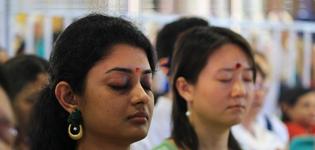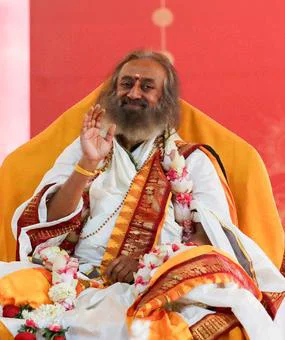

Welcome to Navratri Celebrations 2025
The Navratri celebrations at the Art of Living International Center, Bengaluru are a union of the physical, subtle and conscious aspects of our being through yogasanas, homas, meditation, prayer, sankalpa, seva, satsang and cultural events. Visitors and devotees throughout the world participate in these events to cultivate the highest human qualities. Peace, love, happiness and vibrance are predominant in the Ashram during this event. We welcome you with open arms to join the celebrations presided over by Gurudev Sri Sri Ravi Shankar.
The Significance of Navratri!
"The word ‘Ratri’ means deep rest or relief from three ‘tapas’, three types of fire or botherations- the physical, the subtle, and the conscious. A deep rest can relieve you from all these three botherations.
It’s a time of prayer and rejuvenation. A child is born in nine months. These nine days are like coming out of a mother’s womb once again. Having a new birth."
The Significance of Navratri!
It’s a time of prayer and rejuvenation. A child is born in nine months. These nine days are like coming out of a mother’s womb once again. Having a new birth."
Event Schedule
Date | Event |
| Mon, Sep 22nd - Sat, Sep 27th | 6:30 am - Durga Saptashati Parayana 4:30 pm - Lalitha sahasranam Parayana 7:00 pm - Rudra Puja |
| Sun, Sep 28th | 9:00 am - Maha Ganpathi Homa, Navagraha Homa, Maha Lakshmi Homa, Subramanya Homa |
| Mon, Sep 29th | 7:30 am - Maha Rudra Homa 4:30 pm - Maha Sudarshana Homa 4:30 pm - Vishnu Sahasranamam Parayana |
| Tue, Sep 30th | 7:00 am - Shatha Chandi Homa 4:30 pm - Lalitha Sahasranam Parayana |
| Wed, Oct 1st | 8:30 am - Rishi Homa |
| Thu, Oct 2nd | 9:00 am - Rudra Puja |
| Note: All timings are subject to change. |
Schedule
Date |
Event |
| Fri, April 04th |
7:00 am - Maha Ganpati Homa, Navagraha Homa, Maha Lakshmi Homa 4:30 pm - Chandi Homa Prarambha 6:00 pm - Lalitha Sahasranam Parayanam |
| Wed, Oct 09th |
9:00 am - Maha Rudra Homa 4:30 pm - Maha Sudarshan Homa 4:30 pm - Lalita Sahasranamam Prayanam 5:00 pm - Vishnu Sahasranamam Parayanam |
| Thu, Oct 10th |
7:00 am - Navratri Shat Chandi Homa 6:00 pm - Lalita Sahasranam Parayanam |
| Fri, Oct 11th |
9:00 am - Rishi Homa 6:00 pm - Lalita Sahasranamam Prayanam |
| Sat, Oct 12th |
8:00 am - Vidyarambham (Offline only) 6:00 pm - Lalita Sahasranam Parayanam |
| Wed, Oct 16th |
9:00 am - Jai Durga Homa |
| Note: All timings are subject to change. |
Join the Navratri celebrations
Meditation Programs at Bangalore Ashram

Advanced Meditation Program - 10 Day
*Your contribution benefits a host of social projects

Advanced Meditation Program - 5 Day
*Your contribution benefits a host of social projects

Sanyam Level 2 with Gurudev
*Your contribution benefits a host of social projects
I want to join Navratri but...
How do we attend Navratri this year?
You can attend the Navratri celebrations at Art of Living Bangalore Ashram or watch the live webcast online.
What is a sankalpa?
Sankalpa means intention. The energy created by the homas and pujas held during Navratri can be tapped to strengthen a particular intention. Know more about the power of sankalpa and how it can be taken here.
Can I take sankalpa online?
Are there any online programs that I can do during Navratri?
A number of workshops and programs have been designed to help people to get a deeper experience during Navratri. You can find the list of programs here.Will Gurudev preside over the celebrations?
Yes, Gurudev will be present at the nine-day-long Navratri celebration at the Bengaluru Ashram. All events take place in the presence of Gurudev.
Articles on Navratri Celebration
Chaitra Navratri Live Webcast














